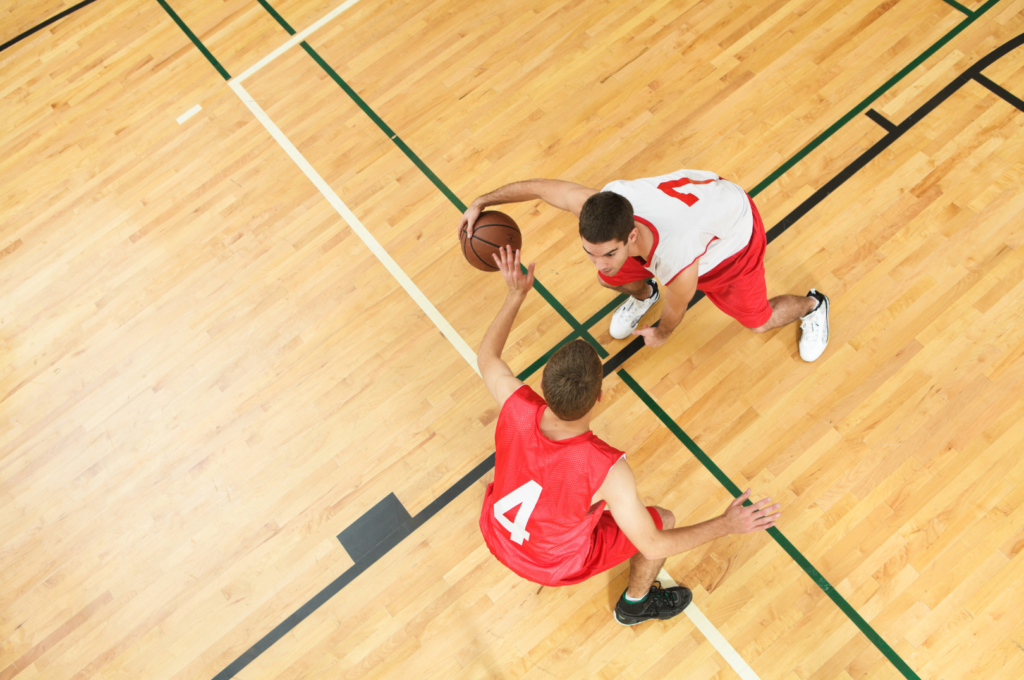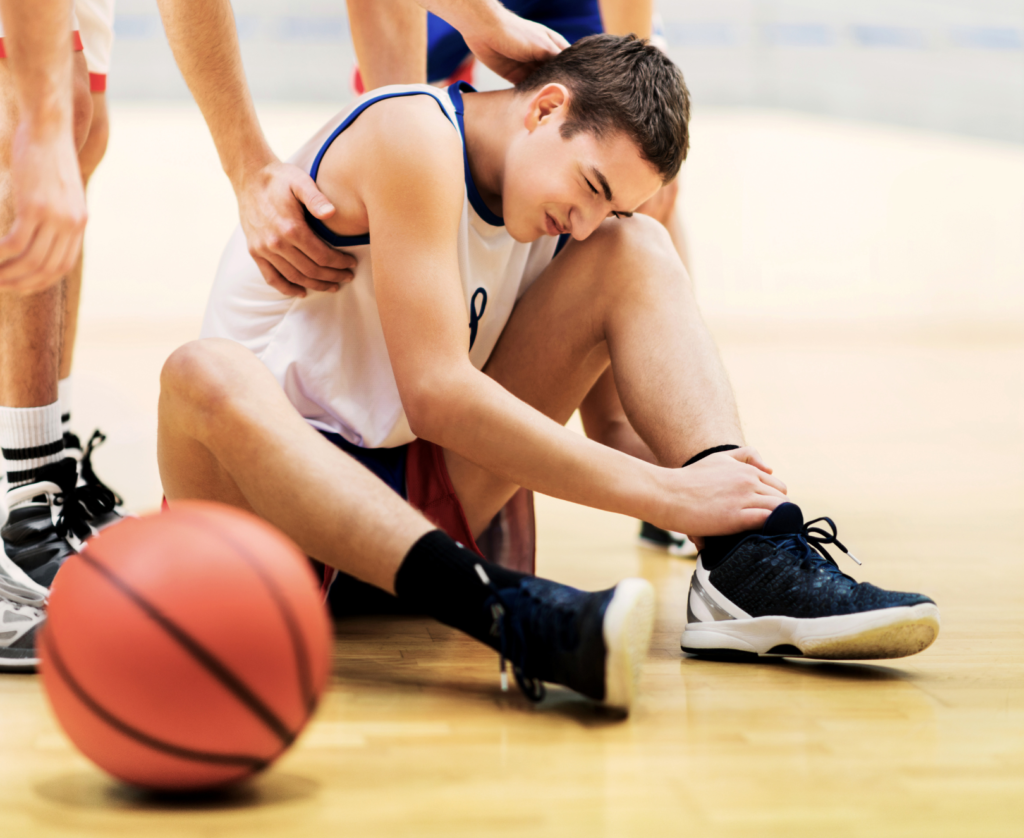
18 Feb Basketball Injuries: Causes And Treatment
 With the fast changes in directions, accelerations and decelerations, running and jumping involved in basketball, it’s little surprise that many players sustain injuries to the feet and legs during or after the game. These movements and actions performed in basketball place a lot of force on the bones, joints, muscles and ligaments. This means that good muscle strength, flexibility, technique, and generally maintaining a good training schedule are very important if you want to help avoid injury and stay in the game.
With the fast changes in directions, accelerations and decelerations, running and jumping involved in basketball, it’s little surprise that many players sustain injuries to the feet and legs during or after the game. These movements and actions performed in basketball place a lot of force on the bones, joints, muscles and ligaments. This means that good muscle strength, flexibility, technique, and generally maintaining a good training schedule are very important if you want to help avoid injury and stay in the game.
As podiatrists that see and treat a wide range of sporting injuries, a few of our top basketball injuries include:
Knee Injuries
Basketball players are at a higher risk of developing knee injuries because of the nature of the sport. The quick changes of direction, jumping, landing, and pivoting motions involved in the game put a lot of stress on the knee joints. Additionally, the repetitive nature of these motions can lead to overuse injuries. There is also a higher risk of contact injuries in basketball, which can happen during collisions with other players.
Anterior cruciate ligament (ACL) injuries are common among basketball players. ACL injuries can occur when the knee is twisted or bent in an awkward way, or when a player lands on a flexed knee. The ACL is often injured in non-contact injuries, such as when a player suddenly changes direction or lands from a jump.
Additionally, the knee’s cartilage (meniscus) can be damaged in basketball players due to the high-stress forces on the knee. Patellar tendinitis (jumper’s knee) is another common knee injury among basketball players. It is caused by the repetitive stress on the patellar tendon, which connects the kneecap to the shinbone.
Proper training and conditioning can help reduce the risk of knee injuries in basketball players, such as strength training and conditioning of the leg muscles, plyometric exercises, and proper warm up and cool down.
Ankle Sprains
Ankle sprains occur when the ligaments that support the ankle are stretched or torn. The most common type of ankle sprain in basketball is an inversion sprain, which occurs when the ankle moves outwards and the foot rolls inwards, creating pain on the outside of the ankle. This can happen when a player lands on another player’s foot or when the foot is planted on an uneven surface. Ankle sprains can happen when the ankle is in a vulnerable position, such as when the foot is pointing outward (eversion), or when the player is landing from a jump or making a quick cut. Many factors can increase the like-lihood of ankle sprains, such as unsupportive footwear, ankle weakness and instability.
Forefoot Pain
 Pain at the front of the foot can be caused by a number of things during basketball, even just from having another player tread or land on your foot. Because a lot of time is spent on the ball of the foot, the joint capsules can become inflamed (capsulitis), the cushion-like sacs between tendon and bone called your bursa can become inflamed (bursitis), the tendons across your forefoot can become inflamed (tendonitis) along with other causes. Clinically speaking, this general forefoot pain is called metatarsalgia.
Pain at the front of the foot can be caused by a number of things during basketball, even just from having another player tread or land on your foot. Because a lot of time is spent on the ball of the foot, the joint capsules can become inflamed (capsulitis), the cushion-like sacs between tendon and bone called your bursa can become inflamed (bursitis), the tendons across your forefoot can become inflamed (tendonitis) along with other causes. Clinically speaking, this general forefoot pain is called metatarsalgia.
We also see players with stress fractures from repetitive stress and overuse of the joints of the midfoot, as well as turf toe, when the big toe hyperextends and becomes sprained.
Sesamoiditis
Sesamoiditis is an overuse injury of the foot that affects the small bones located under the big toe joint, called the sesamoids. These bones are located within the tendon of a muscle called the flexor hallucis brevis and help to distribute weight across the ball of the foot. Sesamoiditis is caused by repetitive stress on and overuse of the sesamoids, which can lead to pain and inflammation.
Basketball players are at risk for developing sesamoiditis due to the high-impact nature of the sport, which involves a lot of jumping and running. The constant pounding of the feet on the hard court can put a lot of stress on the sesamoids, leading to pain and inflammation.
Achilles Tendinopathy
Achilles tendinopathy is a condition that affects the Achilles tendon at the back of the heel, which connects the calf muscles to the heel bone. It is a type of overuse injury caused by repetitive stress on the tendon, which typically occurs from the constant jumping and running during basketball.
Heel Pain
Just like other sports that keep you active on your feet at a high pace, there’s a chance you can develop heel pain at the bottom of your foot, such as plantar fasciitis. Because your plantar fascia is a tissue that spans your arch from the bottom of your feet and into the toes, repetitive movements that strain the fascia can cause it to become damaged or inflamed. Often this is exacerbated by unsupportive footwear that doesn’t help keep the foot in a supported position that minimises strain of many foot structures and tissues. Certain foot types – like a flat foot – can also increase strain on the structures at the bottom of the feet and increase the likelihood of injury.
Shin Splints
Pain to your shins is often associated with fast-paced running and jumping sports, and basketball is no exception. Shin pain occurs from excess tension on the muscles or tissues at the front of the leg or from a bending force on the shin bone itself. It can become very painful and uncomfortable for the player and the pain can continue long beyond when the game finishes. Because technique and tight muscles like the calves can play a big role in the stress to the shins, it’s important to warm up and stretch well and develop good technique.
Masterton Sports Podiatrists
If you’re a basketball player dealing with injury, whether it’s one of the problems we’ve listed above or something else, it’s important to have your injury diagnosed and managed effectively. This is where our sports podiatrists can help.
We’ll start off with a comprehensive assessment to understand the severity of the problem, and create a tailored treatment plan to help you get back to playing the game you love. Book your appointment by calling us on 06 370 4057 or book online here.


